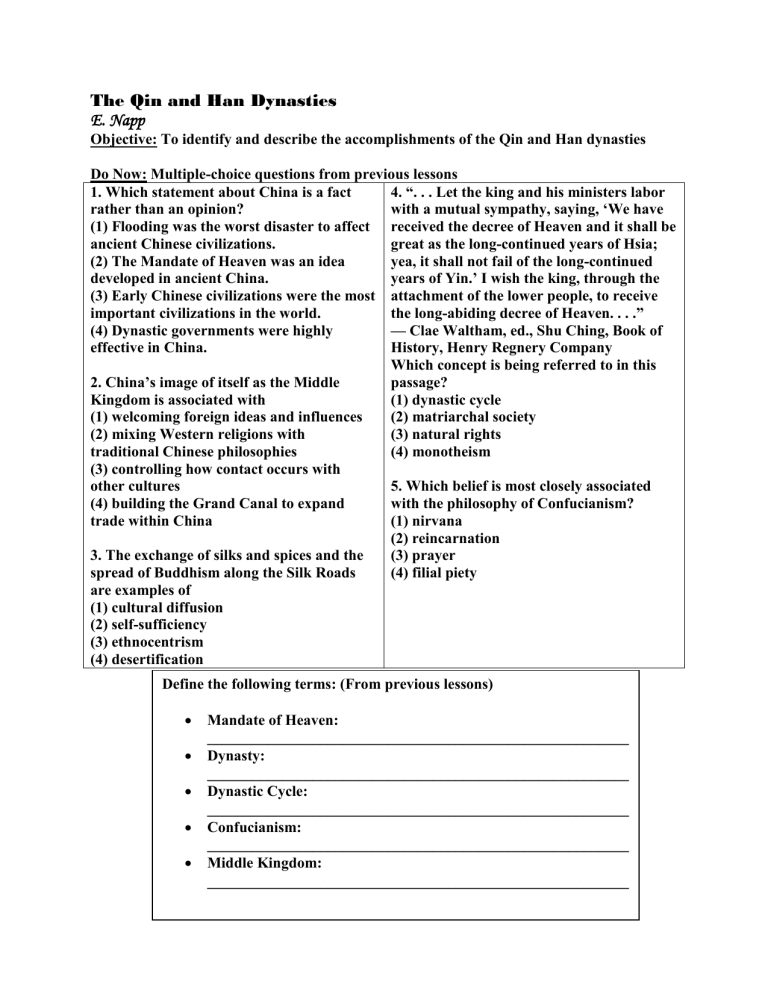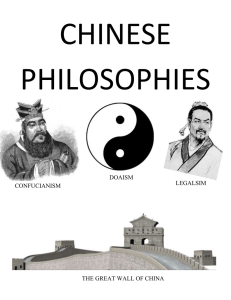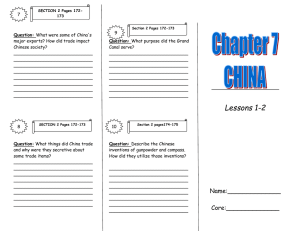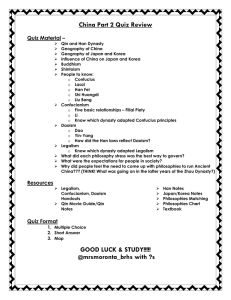
The Qin and Han Dynasties E. Napp Objective: To identify and describe the accomplishments of the Qin and Han dynasties Do Now: Multiple-choice questions from previous lessons 1. Which statement about China is a fact 4. “. . . Let the king and his ministers labor rather than an opinion? with a mutual sympathy, saying, ‘We have (1) Flooding was the worst disaster to affect received the decree of Heaven and it shall be ancient Chinese civilizations. great as the long-continued years of Hsia; (2) The Mandate of Heaven was an idea yea, it shall not fail of the long-continued developed in ancient China. years of Yin.’ I wish the king, through the (3) Early Chinese civilizations were the most attachment of the lower people, to receive important civilizations in the world. the long-abiding decree of Heaven. . . .” (4) Dynastic governments were highly — Clae Waltham, ed., Shu Ching, Book of effective in China. History, Henry Regnery Company Which concept is being referred to in this 2. China’s image of itself as the Middle passage? Kingdom is associated with (1) dynastic cycle (1) welcoming foreign ideas and influences (2) matriarchal society (2) mixing Western religions with (3) natural rights traditional Chinese philosophies (4) monotheism (3) controlling how contact occurs with other cultures 5. Which belief is most closely associated (4) building the Grand Canal to expand with the philosophy of Confucianism? trade within China (1) nirvana (2) reincarnation 3. The exchange of silks and spices and the (3) prayer spread of Buddhism along the Silk Roads (4) filial piety are examples of (1) cultural diffusion (2) self-sufficiency (3) ethnocentrism (4) desertification Define the following terms: (From previous lessons) Mandate of Heaven: ________________________________________________________ Dynasty: ________________________________________________________ Dynastic Cycle: ________________________________________________________ Confucianism: ________________________________________________________ Middle Kingdom: ________________________________________________________ Cornell Notes Outline: The Qin and Han Dynasties (Add Key Words and Summaries) The Key Words: The Summaries: The Notes: I. The Qin Dynasty A. 221 B.C. – 206 B.C. B. Shi Huangdi (Shi Huang-ti) 1- first Qin ruler 2- expanded empire 3- believed in Legalism (Chinese philosophy) a) believed in strong rulers and harsh punishments 1. people are selfish and will only obey if afraid of ruler’s power 4- united previous walls into a Great Wall of China a) protect China from invaders 5- accomplishments a) uniform system of writing b) uniform system of weights and measures II. Han Dynasty A. 206 B.C. – 220 A.D. B. rulers accepted Confucianism 1- order and harmony 2- inferiors obey superiors 3- Five Relationships a) Emperor-subject, Father-son, Husband-wife, Elder Brother-younger brother, Friendfriend 4- Filial Piety a) Sons respect and honor parents and ancestors C. established examination system 1- pass test for government job D. encouraged trade 1- Silk Road a) connected China to Middle East E. compared to Roman Empire 1- had a significant impact on Chinese culture Please read the passage below and answer the questions: In 221 B.C., Shih Huang-ti began a new dynasty, the Qin (or Ch’in). Shih Huang-ti was the first Chinese ruler to call himself “emperor”. Shih believed that people were not always good and required a strong ruler to keep control. His beliefs were part of Legalism, a Chinese philosophy based on the belief that people were selfish and required strong rulers to control them. Shih Huang-ti established a strong central government, built roads, and introduced a uniform system of writing and measurement throughout the empire. He also joined together several existing walls to form the Great Wall of China. The Great Wall protected China from nomadic peoples to the northwest. Stretching over 1,500 miles, it stood 22 feet high and 15 feet thick and took thousands of laborers many years to complete. Shih Huang-ti’s rule was so harsh that his dynasty came to an end just after his death. Questions: Who was Shih Huang-ti? ______________________________________________________________________________ Describe the Chinese philosophy known as Legalism. ______________________________________________________________________________ What were the most significant accomplishments of Shih Huang-ti? ______________________________________________________________________________ Why did the Chinese build the Great Wall of China? ______________________________________________________________________________ The next dynasty, the Han (206 B.C. -220 A.D.), kept China unified for over four hundred years. Han emperors established examinations to select candidates for government service. Candidates were tested on Chinese history and Confucian philosophy which became the official philosophy of dynastic China during the Han dynasty. Examinations were open to all and viewed as a way for a few talented commoners to improve their social position. During the Han Dynasty, merchants established overland trade routes to other centers of civilization. The Silk Road went through Central Asia, connecting China to the Middle East and Rome. Over these routes, China exported silk, iron, and bronze in exchange for gold, linen cloth, glass, ivory, animal hides, horses, and cattle. Contacts with India led to the introduction of Buddhism to China, which became popular during the Han Dynasty. Questions: Why is the Han dynasty frequently compared to the Roman Empire? ______________________________________________________________________________ The Chinese were the first to create a civil service examination to select candidates for government service. What is the advantage of a civil service examination? ______________________________________________________________________________ What was the Silk Road and why was it important? ______________________________________________________________________________ Provide an example of cultural diffusion from the passage above. ______________________________________________________________________________ Word Bank: Dynasty, Examination, Great Wall, Unified, Legalism, Buddhism, Han, Silk Road, Mountains, Confucius 1. ___________ principles describe the qualities that emperors wanted in civil servants. (A) Buddhist (B) Confucian (C) Legalist (D) Daoist 3. The spread of Chinese culture and trade goods throughout Asia is an example of (A) Assimilation (B) Colonization (C) Cultural Diffusion (D) Pax Mongolia 2. The Han dynasty was preceded by the ________ dynasty, which ruled from 221 B.C.E. to 206 B.C.E. (A) Song (B) Shang (C) Zhou (D) Qin 4. ________ exams were formal examinations in Confucianism, history, law, and literature, taken to compete for civil service positions. (A) Admissions (B) Civil service (C) Proficiency (D) Regents




